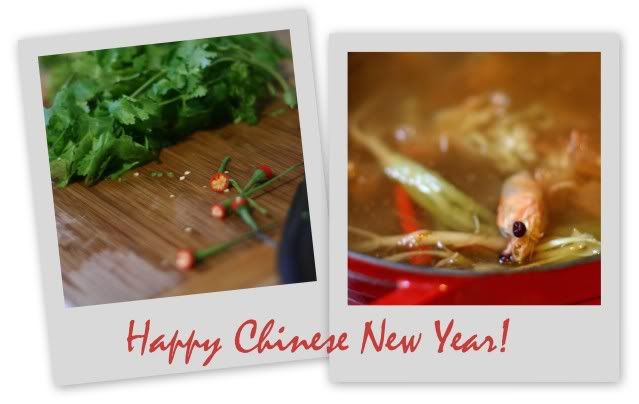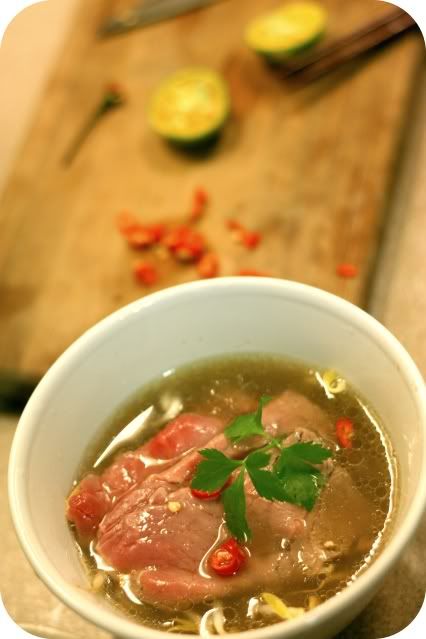I have had a stock of lobster oil sitting pretty in my fridge for a while now. It was something I bought on a whim when I was browsing around Arcangel's in Great World City. At the time I bought it, I had no idea what I was going to do with it, but I knew I had to get it. I was sure I would find a great nesting place for it, in a risotto or a soup.
Today, I decided it had enough rest in my increasingly overcrowded fridge, and took it out for some fun. As I browsed through some of my cookbooks, a particular Chickpea and Langoustine soup tempted me, while another's Sweet Garlic, Bread and Almond Soup looked amazing garnished with some chopped spring onions and drizzled with a few drops of oil. Anyone who knows me well, knows that it's not enough for me to make something that tastes good, it has to look good too. But one thing I would never do, is to compromise the quality of the dish to take a great photo.

In the end, I chose to make a Lentil Soup with small amounts of roasted sweet garlic and caramelised onions. Lobster oil and lumpfish caviar then finished off the bowl of soup. To make the soup, I used some seafood stock I had made many moons ago and kept in my freezer for a special day. I did everything within my means to make the soup as flavourful as it could be, without coming up with something that would be too strong to handle the lobster oil. Towards the end, I thought the salt would finally bring all the flavours together, as it usually does. But when it didn't, I was dumbfounded.
What else could I possibly have missed out? Good seafood stock - check. Yummy sweet, oozy roasted garlic - check. Freshly made onion relish - check. Salt and pepper - check. A splash of wine, a dash of vinegar - check, check. But no matter how much of the soup I tasted, something was missing. I couldn't believe I could fail in making something as simple as Lentil Soup.
Then I thought of what my grandmother would do. As a Cantonese, her dishes are rather extreme in tastes. Subtlety is not an existing word in her vocabulary. The flavours leap right at you rather than dance around on your tongue with every mouthful. To achieve that, she never stinges on salt, and sugar. So that's exactly what I did, I added sugar.
It's not uncommon for sugar to be added in savoury dishes. I've seen plenty of recipes, especially those featuring tomatoes, with a touch of sugar to tame tartness and enhance the sweetness of the tomatoes. I have no idea what forces combined in the lentil soup I was making, but the sugar did it. Just half a tablespoon of precious white crystals brought all the flavours together, giving me an extremely joyous feeling.
I did a little victory dance around the kitchen (it was very little, considering how little standing space there was available) then scooped out a little bowl for myself. It was velvety and hearty, yet sophisticated with a few drops of bright red lobster oil and the almost luminiscent pearls of caviar.
The only tool one would need to make a soup as simple as this, is a sturdy heavy duty blender, preferably made with glass that can take the high heat. I used to have a plastic one and would constantly fret that the plastic would crack or worse, that it would impart some incredibly off-putting plastic taste to the soup. So now that I have my glass one, there's no way I'm looking back!
Lentil Soup
Serves 6-8 as a starter
Ingredients
half a bulb of garlic
2 cups red lentils
5 cups homemade vegetable/seafood stock
1 tbspn olive oil
1 big white onion, sliced
2 tbspns good white wine
1 tbspn white wine vinegar
salt, pepper and sugar to taste
Lobster oil, caviar, or dried sakura ebi (optional)
Method
Preheat oven to 180 degrees celcius.
Place garlic in oven and roast for half an hour or until flesh is soft.
Boil lentils in stock until soft.
Meanwhile, heat olive oil in pan at medium heat and add onions then turn down heat to low.
When onions turn translucent, add white wine and vinegar.
Continue cooking and stirring until onions are caramelised and brown
Remove flesh from garlic skin, and add to boiling lentil soup with the onions.
Puree in a blender until smooth, then strain if preferred (I chose not to) back into pot.
Add salt, pepper and sugar to taste.
Spoon into bowls and drizzle lobster oil and garnish with caviar or dried sakura ebi if available.








